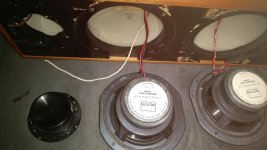The red/positive terminal gives me a continuity sound upon testing, but the black/negative does not. As mentioned, the black/neg side is the one with the capacitor you (hopefully) see in this post.
What has not been stated in this thread is that capacitors will show as 'open' connections in terms of continuity using a DMM. They will not appear to be a connected component. Coils and resistors are read as connected on a DMM if they are valid parts.
Later,
Wolf
Oh no, this really throws a spanner in the works! I am a complete beginner at using a digital multi-meter -- is there anything I can change on the settings to get a reading?
If this is the case, and I shouldn't expect any continuity signal, I am back to square one as far as what is broken on this tweeter.
I have ordered two of these (Seas 25TAFC/G H0427-06 Tweeter - Prestige Series), due to arrive on the 2nd Jan. I was informed these are basically identical the to the OEM. I would like to get the original working if possible though.
Thanks wolf_teeth for passing on the knowledge about the open connection re: capacitors. I would have taken it as fact I needed to replace the cap. Indeed, I have already ordered some!
If this is the case, and I shouldn't expect any continuity signal, I am back to square one as far as what is broken on this tweeter.
I have ordered two of these (Seas 25TAFC/G H0427-06 Tweeter - Prestige Series), due to arrive on the 2nd Jan. I was informed these are basically identical the to the OEM. I would like to get the original working if possible though.
Thanks wolf_teeth for passing on the knowledge about the open connection re: capacitors. I would have taken it as fact I needed to replace the cap. Indeed, I have already ordered some!
So here is the question- do both tweeters actually make sound? Does the sound actually seem okay? If not- have you looked into both cabinets to identify if everything is intact and identical? Do both tweeters measure with the ~same value on the DMM when disconnected from the circuit?
Honestly, an LC meter, impedance analyzer, or O-scope are what's required to tell if a capacitor is bad.
Later,
Wolf
Honestly, an LC meter, impedance analyzer, or O-scope are what's required to tell if a capacitor is bad.
Later,
Wolf
I've only the one tweeter out of the box. The other ES22 is working (I've not actually tested it but I was assured it does). So I've left it intact. The speakers arrived with the one tweeter disconnected. I have unscrewed the other two loudspeakers (see attached).
The tweeter gives resistance of "05.3" when the DMM set to 200, that's the lowest it goes. This is the same, roughly (it's a cheap Ebay Digital Multi-Metre), on each of the other speakers that I've unscrewed from the cabinet (but left attached to their wires).
I read somewhere to test a tweeter by attaching an AA battery to see if it responds. I attached a 1.2v recharageable and the diaphragm moved in a uniform manner - and made a sound - when thus connected.
Apologies for my lack of experience and knowledge when using the DMM. I am completely new to any kind of electronics.
The only other information I can give is the previous owner said he had a surge of power through his valve amps, there was a popping sound, and this one tweeter stopped working.
The tweeter gives resistance of "05.3" when the DMM set to 200, that's the lowest it goes. This is the same, roughly (it's a cheap Ebay Digital Multi-Metre), on each of the other speakers that I've unscrewed from the cabinet (but left attached to their wires).
I read somewhere to test a tweeter by attaching an AA battery to see if it responds. I attached a 1.2v recharageable and the diaphragm moved in a uniform manner - and made a sound - when thus connected.
Apologies for my lack of experience and knowledge when using the DMM. I am completely new to any kind of electronics.
The only other information I can give is the previous owner said he had a surge of power through his valve amps, there was a popping sound, and this one tweeter stopped working.
Attachments
If the ferro-fluid was all dried up, would that stop a tweeter working? I'm grasping at straws really, as the previous owner said there was a definite popping sound and the tweeter stopped working. I can't see any cracks in the aluminium dome, and the coil appears intact. It is definitely in need of new ferro-fluid, but it isn't like it was totally dried up.
Ok, so I did solder the tweeter back in to see what happened. It made sound but crackled. It really sounds like a cracked diaphragm, even though I can't see any cracks. So, it has come out again as I await the replacement tweeters.
Hi
I am experiencing the exact same issue as you. Today, I pulled my ES22s down from the loft after a few years and one of the tweeters no longer works. I'm really keen to learn whether you solved your issue by replacing the capacitor or the complete tweeter itself with the Seas model.
Any updates much appreciated.
Thanks
This is an old thread, and TBH, i am slightly confused by the exact capacitor value, but it is certainly near to 1.6uF.
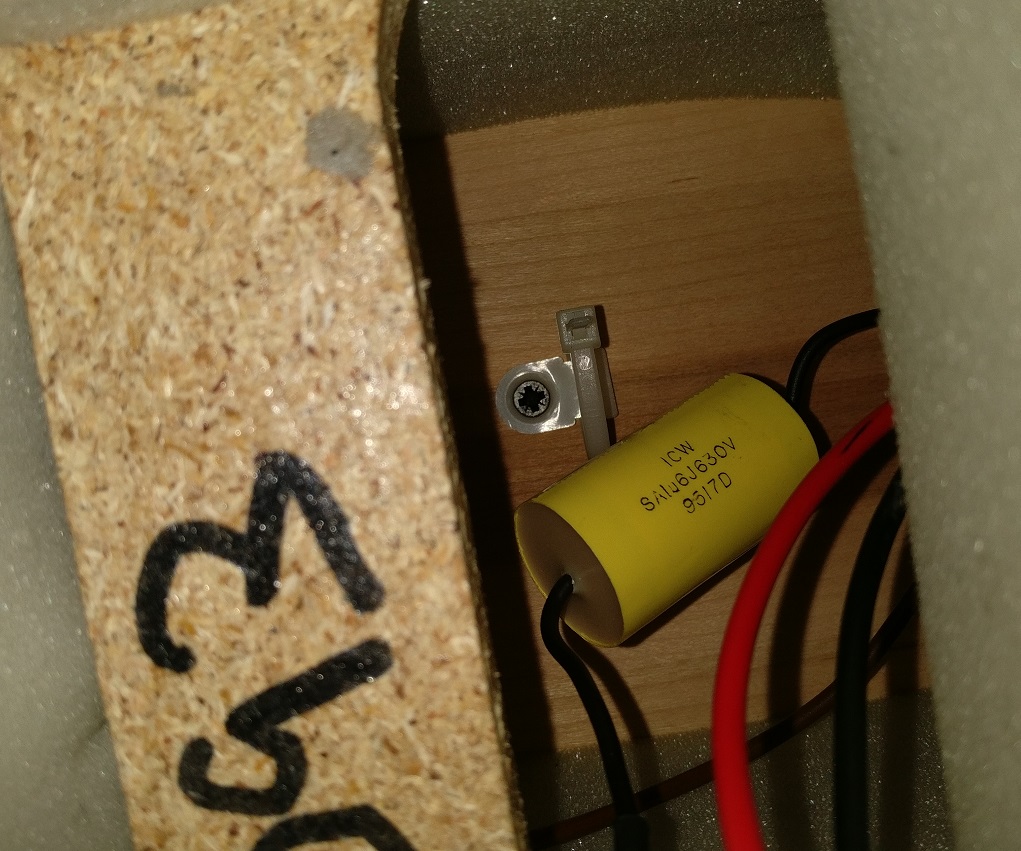
What we know is this is an Epos 22:
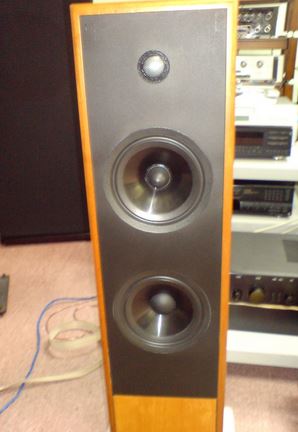
This is the approximate crossover filter:
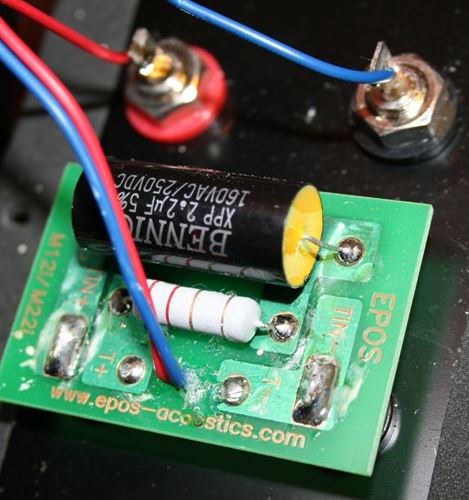
If I was a betting man, I'd say the chances of a 630V 5% MKP capacitor popping are next to zero.
Far more likely the tweeter has popped. What I suggest you do, is measure the tweeter with a good multimeter:
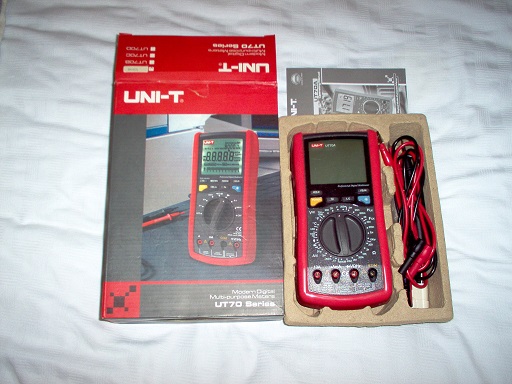
It should come out at about 4ohms. This is how tweeters look when you take them apart:
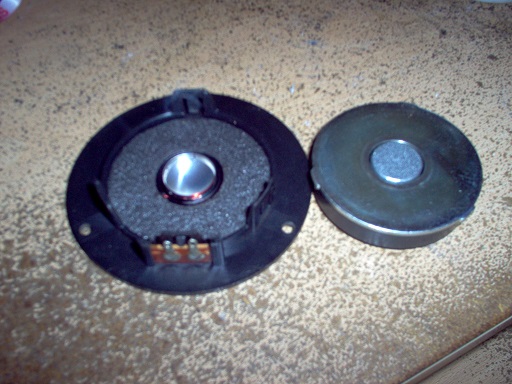
Many ways in which the wires break. Either the tweeter is broken, or the crossover wiring. If it was OK when you stuck it in the attic, I'd suspect broken wiring. Reflow the solder joints with a 40W iron and all might be well.
What we know is this is an Epos 22:
This is the approximate crossover filter:
If I was a betting man, I'd say the chances of a 630V 5% MKP capacitor popping are next to zero.
Far more likely the tweeter has popped. What I suggest you do, is measure the tweeter with a good multimeter:
It should come out at about 4ohms. This is how tweeters look when you take them apart:
Many ways in which the wires break. Either the tweeter is broken, or the crossover wiring. If it was OK when you stuck it in the attic, I'd suspect broken wiring. Reflow the solder joints with a 40W iron and all might be well.
Steve. Really appreciate you taking the time to reply with this. I'm going to take the tweeter out at the weekend and test it as you suggest and also check the wiring by reflowing the joints. We'll see. In order to test with a multimeter, I'll need to disconnect the tweeter first, right?
Thanks
Thanks
Steve. Really appreciate you taking the time to reply with this. I'm going to take the tweeter out at the weekend and test it as you suggest and also check the wiring by reflowing the joints. We'll see. In order to test with a multimeter, I'll need to disconnect the tweeter first, right?
Thanks
If the tweeter cable is hard-soldered, you can test it in place. Because it is, in this particular case, actually isolated from the DC path by the capacitor. IDK if there is a tiny 47R resistor across it which is just a radio frequency bit of tinkering you sometimes find with Epos speakers, but time will tell.
Connect the probes of your resistance (R) meter to the two terminals with the 200R scale for sensitivity. You should get a reading of near 5.3R if Gabriel is to be trusted.
Another test is to connect a 1.5V AA or AAA penlight battery loosely across the terminals. You get a crackly noise if all is well. I have used a pair of nail scissors and a battery to do this. The theory says the dome moves forward when plus is connected to plus.
Amazingly, you can test a tweeter with nothing more than a paperclip, and without taking the speaker apart. You connect the paperclip deliberately loosely across the speaker terminals and push the bass cone in to generate a back EMF. You get a crackle from the tweeters with a loose connection.
The second thing to consider is dried-up Ferrofluid.
This is a magnetic oil often applied to the voicecoil gap of speakers (on the right) to improve cooling. After 20 years the kerosene often dries out and the iron oxide settles into something resembling Marmite. If the tweeter measures OK but has no or little output, this can be the cause. You need to take the tweeter apart to check this. This can require a delicate touch to lift the voicecoil off vertically without scraping the enamelled copper voicecoil in the gap. But we are, after all, PROFESSIONALS!
Last edited:
This is an old thread, and TBH, i am slightly confused by the exact capacitor value, but it is certainly near to 1.6uF.
The code in the picture ... SA1u6J630v ... Series SA 1.6uf J? 630volts
Well, I got diddly squat with regards a reading from the tweeter on my multi-meter. I guess I draw the conclusion that it has actually blown then?
If nothing to be done I'll have to buy one. According to Falcon Acoustics my closest mack would be this
Seas 27TAFC/G H0883-06 Tweeter - Prestige Series
If nothing to be done I'll have to buy one. According to Falcon Acoustics my closest mack would be this
Seas 27TAFC/G H0883-06 Tweeter - Prestige Series
Well, that's a bit of heartbreak! I did say the chances of the strangely non-standard 1.6uF 630V J (5%) Capacitor failing were next to zero! And, this is why I got suspicious, 1.5uF is the preferred value.
One of the most gifted people at this forum is Joachim Gerhard. Like me, he rates high on the Autistic spectrum. And what is wrong with THAT!
Bottom line, and I am trusting Joachim on this, go get yourself a pair of Seas 27TBCD/GB-DXT H1499-06 Tweeter - Prestige Series
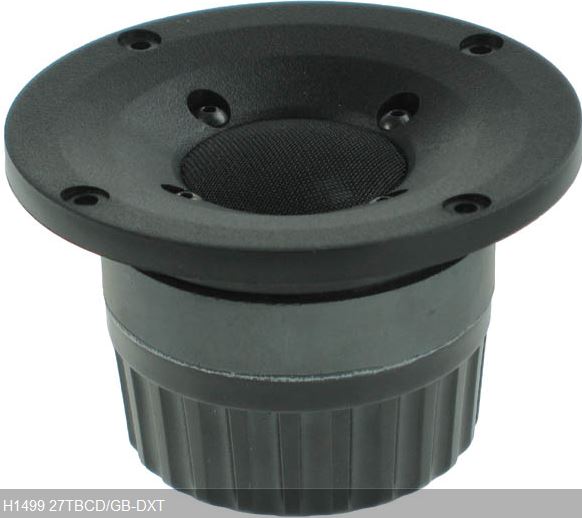
.
Joachim told me these work well on a single cap crossover. AFAIK, 104mm cutout. Just add resistor for level. Seemples!
One of the most gifted people at this forum is Joachim Gerhard. Like me, he rates high on the Autistic spectrum. And what is wrong with THAT!
Bottom line, and I am trusting Joachim on this, go get yourself a pair of Seas 27TBCD/GB-DXT H1499-06 Tweeter - Prestige Series
.
Joachim told me these work well on a single cap crossover. AFAIK, 104mm cutout. Just add resistor for level. Seemples!
Last edited:
- Status
- This old topic is closed. If you want to reopen this topic, contact a moderator using the "Report Post" button.
- Home
- Loudspeakers
- Multi-Way
- Help to identify capacitor in Epos ES22
